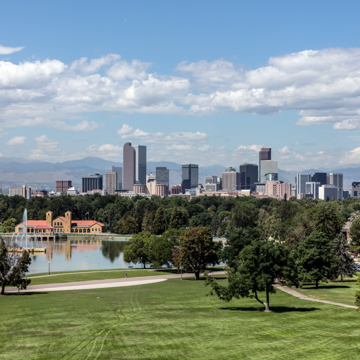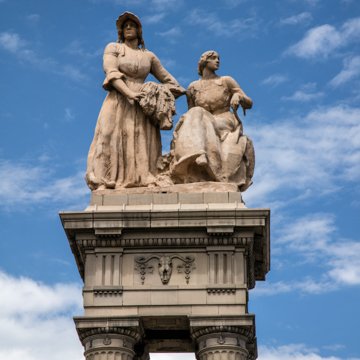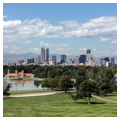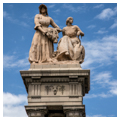City Park is Denver's largest (317 acres) and most elaborate, with notable buildings, sculpture, a zoo, and a natural history museum. Harry Meryweather, a city civil engineer, laid out the park in the Olmsted tradition, using a romantic, informal plan of looping drives and walks around lakes. Landscaping ranges from dense tree planting and shrub massing to grassy expanses. George Kessler, the Olmsted brothers, and Saco R. DeBoer also had a hand in shaping City Park. The Pavilion (1896) and the Floating Bandstand (1896; 1929, Fisher and Humphreys) at the west end of Ferril Lake were restored in the 1990s as part of a local historic district that includes the park superintendent's house (1893) near the McLellan Gate (1903) on York Street.
City Park is formally approached from East Colfax Avenue by City Park Esplanade (1905), guarded by the Sullivan Memorial Gateway (1917, Leo Lentelli, sculptor), with heroic twin figures atop tall columns representing mining and agriculture. Unfortunately, the 12-foot-high figures, made of concrete reinforced with steel, have become crumbling lepers that the city plans to replace with fiberglass clones. Edward H. Bennett, the Chicago city planner and architect who designed that city's Grant Park and provided one of the schemes for Denver Civic Center, planned the fountain and gateway of the Esplanade, which is also the main artery through the campus of East High School. The north end of the Esplanade enters City Park at the Thatcher Memorial Fountain (1918, Lorado Taft, sculptor), a composition of granite, bronze, and water culminating in an 18-foot female figure armed with a sword and shield. The Sopris Gateway (1912, Frank E. Edbrooke), East 17th Avenue between Detroit and Fillmore streets, commemorates Richard Sopris, a mayor of Denver and the city's first park commissioner.
The Denver Zoological Gardens ( DV133.1; 1896), which supposedly began when Denver's park superintendant was given a troublesome pet bear cub, has become a large complex of architectural habitats for animals. Bear Mountain (1918) (NR) was the creation of zoo director Victor H. Borcherdt. It is made of structural steel and concrete to resemble a hogback west of Denver, with barless bear pits and native landscaping. Newer attractions include Northern Shores (1989, Alan Petersen), with subterranean polar bear pool viewing, and the huge glass pyramid housing Tropical Discovery (1993, Anderson, Mason, Dale). The Denver Museum of Natural History ( DV133.2; 1908, Frederick J. Sterner; many additions), 2001 Colorado Boulevard, is Colorado's most popular and distinguished museum. The original classical temple on a hill is now hidden under precast concrete and glass additions.



















